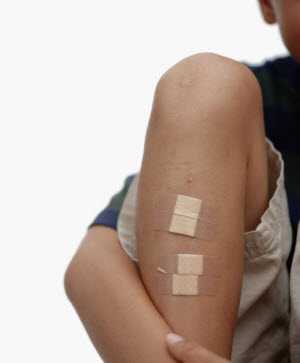General Information About MRSA in the Community
 MRSA is methicillin-resistant Staphylococcus aureus, a type of staph bacteria that is resistant to several antibiotics. In the general community, MRSA most often causes skin infections. In some cases, it causes pneumonia (lung infection) and other issues. If left untreated, MRSA infections can become severe and cause sepsis - a life-threatening reaction to severe infection in the body.
MRSA is methicillin-resistant Staphylococcus aureus, a type of staph bacteria that is resistant to several antibiotics. In the general community, MRSA most often causes skin infections. In some cases, it causes pneumonia (lung infection) and other issues. If left untreated, MRSA infections can become severe and cause sepsis - a life-threatening reaction to severe infection in the body.
In a healthcare setting, such as a hospital or nursing home, MRSA can cause severe problems such as bloodstream infections, pneumonia and surgical site infections. For more information visit MRSA in healthcare settings.
- Who Is At Risk, and How Is MRSA Spread In The Community??
- How Common is MRSA?
- Can I Prevent MRSA? How?
- What are MRSA Symptoms?
- What Should I Do If I See These Symptoms?
- What Should I do if I Think I Have a Skin Infection?
- How to Prevent Spreading MRSA
Who Is At Risk, and How Is MRSA Spread In The Community?
Anyone can get MRSA on their body from contact with an infected wound or by sharing personal items, such as towels or razors, that have touched infected skin. MRSA infection risk can be increased when a person is in activities or places that involve crowding, skin-to-skin contact, and shared equipment or supplies. People including athletes, daycare and school students, military personnel in barracks, and those who recently received inpatient medical care are at higher risk.
How Common Is MRSA?
Studies show that about one in three people carry staph in their nose, usually without any illness. Two in 100 people carry MRSA. There are not data showing the total number of people who get MRSA skin infections in the community.
Can I Prevent MRSA? How?
There are the steps you can take to reduce your risk of MRSA infection:
- Maintain good hand and body hygiene. Wash hands often, and clean your body regularly, especially after exercise.
- Keep cuts, scrapes and wounds clean and covered until healed.
- Avoid sharing personal items such as towels and razors.
- Get care early if you think you might have an infection.
What are MRSA Symptoms?
Sometimes, people with MRSA skin infections first think they have a spider bite. However, unless a spider is actually seen, the irritation is likely not a spider bite. Most staph skin infections, including MRSA, appear as a bump or infected area on the skin that might be:
- Red
- Swollen
- Painful
- Warm to the touch
- Full of pus or other drainage
- Accompanied by a fever
Click here for photos of MRSA infections.
What Should I Do If I See These Symptoms?
If you or someone in your family experiences these signs and symptoms, cover the area with a bandage, wash your hands, and contact your doctor. It is especially important to contact your doctor if signs and symptoms of an MRSA skin infection are accompanied by a fever.
What Should I do if I Think I Have a Skin Infection?
- You can’t tell by looking at the skin if it is a staph infection (including MRSA).
- Contact your doctor if you think you have an infection. Finding infections early and getting care make it less likely that the infection will become severe.
- Do not try to treat the infection yourself by picking or popping the sore.
- Cover possible infections with clean, dry bandages until you can be seen by a doctor, nurse, or other health care provider.
How To Prevent Spreading MRSA
- Cover your wounds. Keep wounds covered with clean, dry bandages until healed. Follow your doctor’s instructions about proper care of the wound. Pus from infected wounds can contain MRSA so keeping the infection covered will help prevent the spread to others. Bandages and tape can be thrown away with the regular trash. Do not try to treat the infection yourself by picking or popping the sore.
- Clean your hands often. You, your family, and others in close contact should wash their hands often with soap and water or use an alcohol-based hand rub, especially after changing the bandage or touching the infected wound.
- Do not share personal items. Personal items include towels, washcloths, razors and clothing, including uniforms.
- Wash used sheets, towels, and clothes with water and laundry detergent. Use a dryer to dry them completely.
- Wash clothes according to manufacturer’s instructions on the label. Clean your hands after touching dirty clothes.
- Page last reviewed: February 9, 2016
- Page last updated: March 25, 2016
- Content source:


 ShareCompartir
ShareCompartir